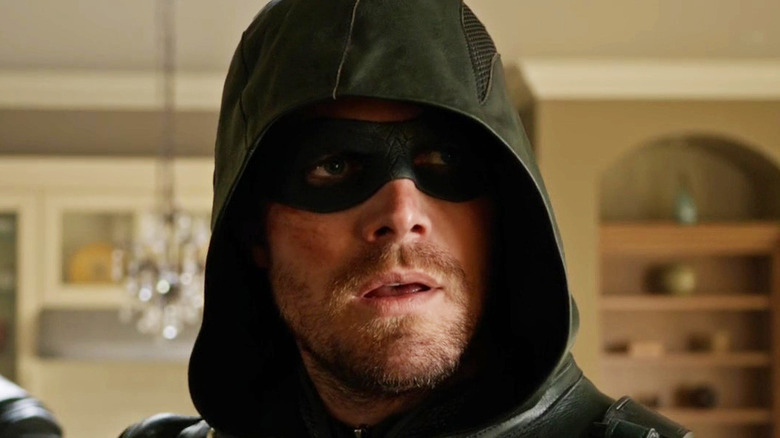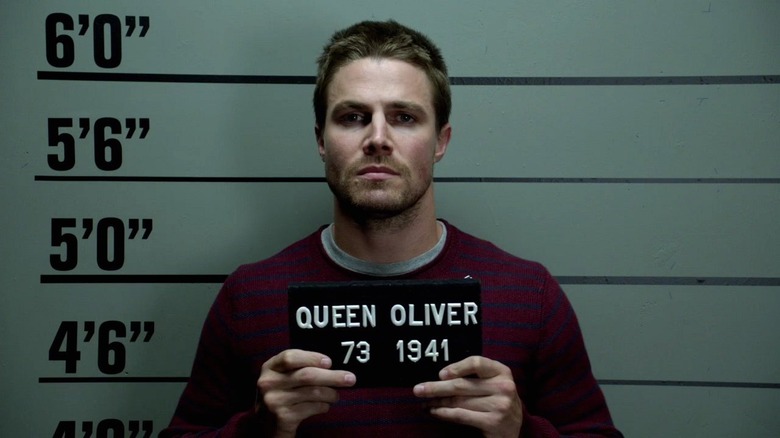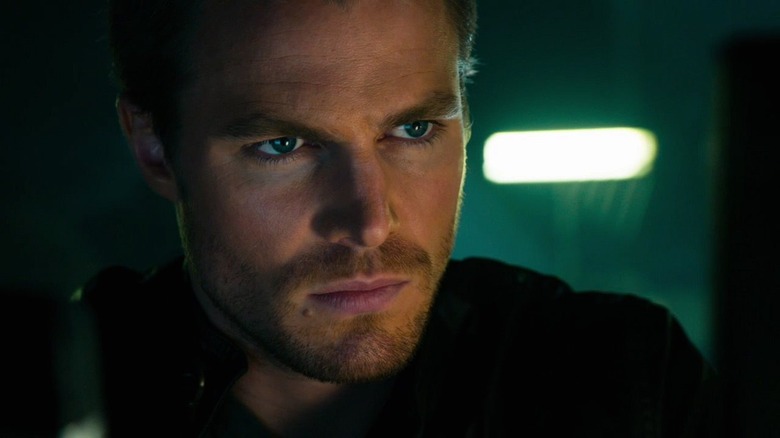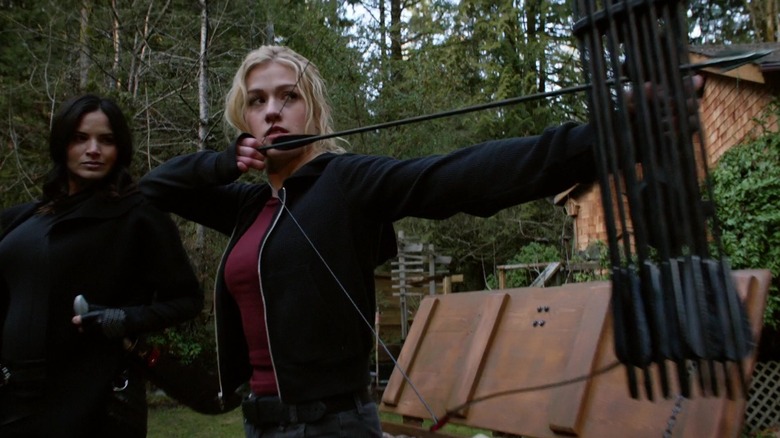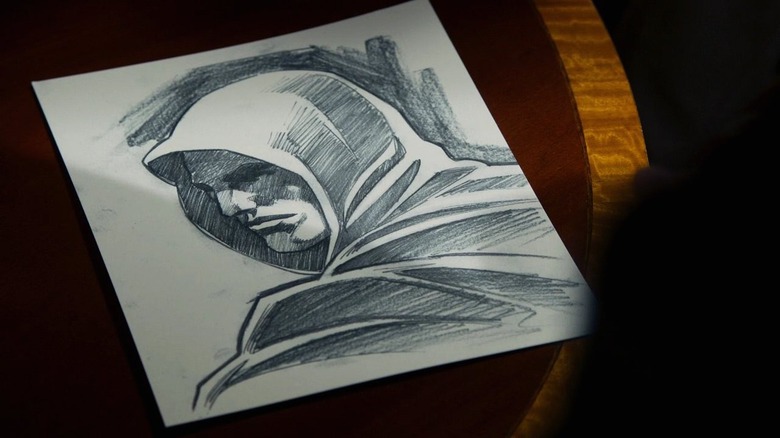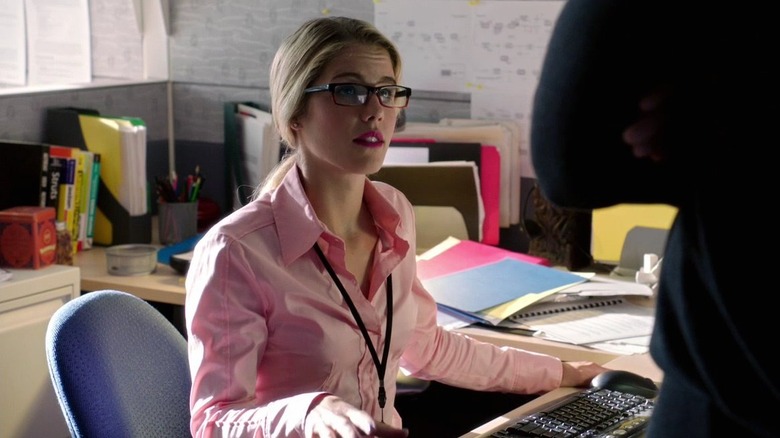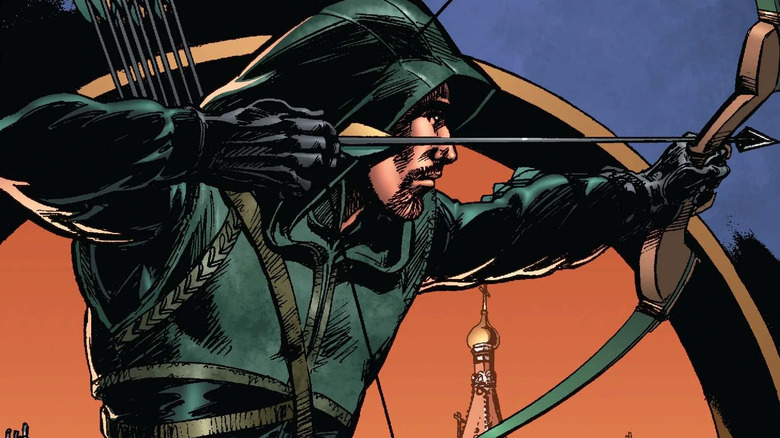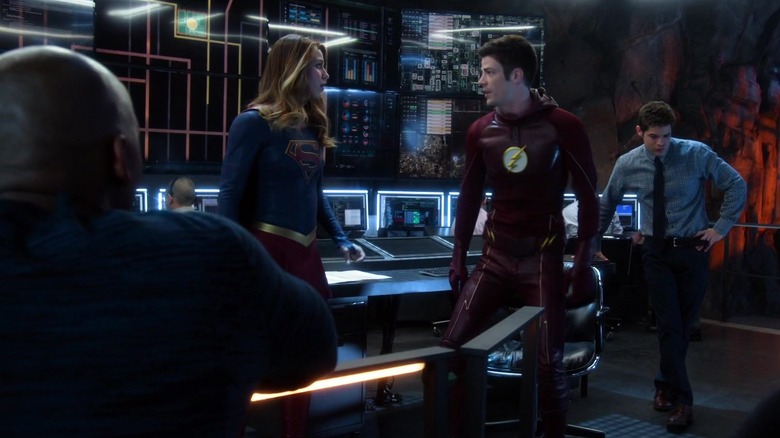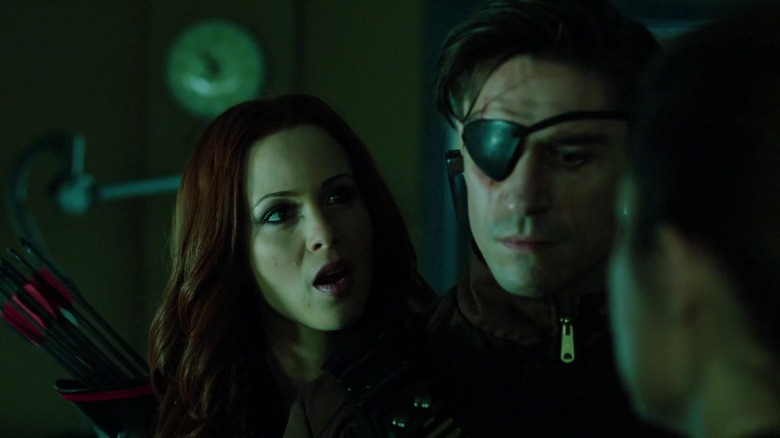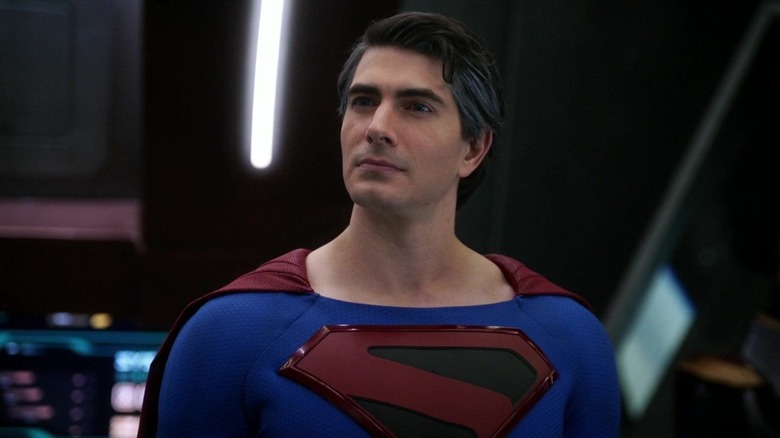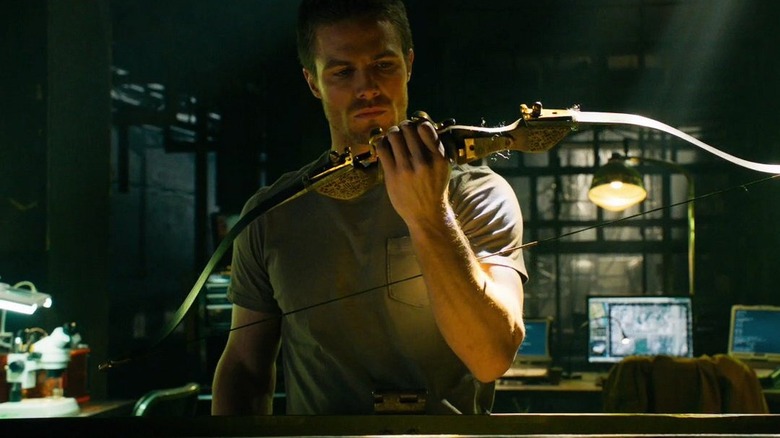How Arrow Changed Comic Book Shows And No One Noticed
When "Arrow" premiered in 2012, it lacked a direct connection to a movie franchise like the Marvel Cinematic Universe. It was also created in the shadow of "Smallville," which enjoyed a lengthy and successful run. Unlike "Smallville," which is hopeful from the beginning, "Arrow" centers around traumatized billionaire Oliver Queen (Stephen Amell) as he evolves from a brutal vigilante into a true hero.
But none of this proved to be a hindrance. In fact, "Arrow" ended up creating a new standard for comic book shows. Though it's far from the first superhero series, it transformed the way these stories are brought to the small screen, the way they're marketed, and the storytelling scope they can aim for. It's no wonder, really, that "Arrow" launched multiple spin-offs and brought the DC multiverse to live-action life before the DCEU films did. We're here to explore how "Arrow" changed comic book shows forever, right under everyone's noses.
Failed movie, successful show
Like many comic book characters, Green Arrow has been attached to several potential live-action adaptations. One of the earliest plans to bring the Emerald Archer to the silver screen was a proposed film titled "Green Arrow: Escape from Super Max." According to an interview Justin Marks did with MTV News in 2008, this film would have situated Oliver Queen in a highly complex prison built for dangerous meta-humans. To make his way out, he'd have to use every ounce of his intelligence, creativity, and skill, as well as team up with a fascinating array of villains.
Sadly, this interesting take on the character wasn't turned into a movie. As David S. Goyer recounted, this innovative idea didn't go over well with higher-ups who didn't believe moviegoers would turn out for a film full of bad guys. After this defeat, Green Arrow's adventures might have been limited to comic books and guest appearances on shows like "Smallville." But "Arrow" averted this destiny. Its take on the character showed that poorly-known heroes with a failed project (or two) under their belts could still find a mainstream audience, as well as financial success. This cleared the way for shows like "Batwoman" and "Moon Knight" to take shape.
From the C-list to the A-list
Green Arrow has historically been seen as a B or C-list character. While this means he hasn't enjoyed the kind of notoriety big names like Superman or Batman have, it also means he had the opportunity to prove doubters wrong. As "Arrow" found success, DC took notice. This is most evident in the show's incorporation of more popular characters, as star Stephen Amell discussed with HeyUGuys in 2013 while promoting "Arrow" Season 2. While he didn't name names at the time, only indicating that some big personalities were headed their way, Season 2 boasts an appearance from Barry Allen (aka the Flash), while Season 3 features the Atom and Ra's al Ghul.
In proving that overlooked characters could still be made relevant and cool, "Arrow" found major success. This triumph allowed it to bring bigger names into its orbit, which ended up making the show even more exciting, rather than tarnishing the roped-in A-listers. This directly led to shows like "Supergirl" bringing in heavy-hitters like Superman, and an overall richer and more complex fictional universe.
Arrow imagines a better world
Many major comic book characters were created with political commentary at their cores. Superman's earliest stories see him embody progressive politics. Captain America's first appearance has him punching Hitler. Wonder Woman rails against the forces that keep women down. Green Arrow is no different — in a sense. While he began as something of a Batman rip-off, he's become a character driven by a desire for social justice. This is one of the many reasons series co-creator Greg Berlanti wanted to develop "Arrow," as he explained on a panel hosted by the Paley Center for Media.
This hunger for a better world appeals to a politically progressive demographic. It also organically allowed the writers of "Arrow" to explore a wealth of political topics. Given the fact that "Arrow" went on to evolve into the Arrowverse, this created a foundation for later live-action comic book shows to be explicitly and unapologetically political in a myriad of ways.
Embracing comic book tropes
While some comic book shows like "Smallville" have enjoyed major success, this was seen as something of a fluke when "Arrow" debuted. After all, while that Superman-centric series was on the air, many other comic book shows premiered and were quickly canceled, including "Mutant X," "Birds of Prey," "Blade: The Series," and "Human Target." Moreover, "Smallville" was seen as a success because of its "no tights, no flights" rule, which had the show downplay its more comic book-y elements. As the 2010s dawned, it was starting to seem like superhero shows could only succeed if they shed the genre's classic conventions.
Then "Arrow" arrived. Not only does "Arrow" make Oliver Queen's classically superheroic outfit look awesome, the series successfully adapts comic book stories without ever becoming hokey. Characters wear domino masks, storylines tip into melodrama, and alternate universes like Earth-2 make major appearances. "Arrow" proved that comic book shows could triumph without having to pretend to be something they aren't. Masks, over-the-top bad guys, and colorful superpowers aren't a death knell — they can even be a show's biggest asset.
Making room for women
Superhero media has long struggled with gender representation. "Arrow" is an interesting artifact of this history. On the one hand, it brought more male viewers to The CW: As TV Guide reported, the network's viewership was 30% male in 2011, and 50% in 2017. But "Arrow" didn't accomplish this by shutting women out. The series' smart, complex, capable female characters actually helped normalize depictions of superheroines in comic book shows. A clear sign of this success can be seen in the fact that "Supergirl" and "Batwoman" were greenlit within a handful of years. Moreover, while "Legends of Tomorrow," has an ensemble cast, it largely focuses on Sara Lance.
Crucially, the Arrowverse has gone on to celebrate female friendships, rather than define its fictional women by the men in their lives. These aren't shallow butt-kickers or wilting flowers — they're fully fleshed-out characters in their own right, with their own complicated links to the world around them. "Arrow" acted as a signal flare, indicating that the success of comic book shows was not dependent on highlighting men and excluding women. Shows like "Supergirl" and "Batwoman" followed up on this in spectacular fashion.
A new world of transmedia storytelling
Many popular television franchises have produced tie-in media content. Typically, these are standalone books or comic books. So it goes with "Arrow," which produced a digital comic series. This isn't a series related to the show in name only, however – it's deeply intertwined with the events of the series, and features stories from the show's writers and producers.
The transmedia nature of "Arrow" is so distinct that academic Charles Joseph of the University of Rennes has written about how this element of the show contributed to its success. Before "Arrow" came along, "Smallville" produced comic books as a sequel to the show. In contrast, the comics that tie in to "Arrow" were published as part of the show's ongoing narrative. This creates a unique link between the show and the comic book medium from which it springs. "Arrow" thus became a truly transmedia experience, with consumption of its storytelling taking place across multiple mediums at the same time. This set a new foundation for transmedia work that other live-action superhero shows could follow.
Launching the Arrowverse
Spin-offs and sequel shows are nothing new. Consider the "Star Trek" franchise, which encompasses over 10 television series (to say nothing of its many movies). This is a huge number of productions, but few of these shows have ever overlapped. In contrast, the success of "Arrow" is marked not only by the number of spin-offs it generated, but also by the fact that many of them ran concurrently.
"Arrow" began in 2012. In 2014, it was joined by "The Flash." The floodgates were well and truly open after that: "Supergirl" debuted in 2015, "Legends of Tomorrow" in 2016, "Black Lightning" in 2018, and "Batwoman" in 2019. This means that during its eight seasons, "Arrow" existed alongside five other shows that are part of its shared universe.
The "Arrowverse" that emerged from these interconnected shows is groundbreaking and incredibly unique, as one of the most complex superhero narratives to ever hit TV. In pulling this off, "Arrow" proved that a comic book show could successfully juggle a variety of standalone and interwoven story arcs, just as its ink-and-paper source material can.
Beating the movies to the punch
In 2012, Marvel found major success with "The Avengers," just four years after 2008's "Iron Man" hit theaters. But while Marvel was building its cinematic universe, DC Comics' silver screen productions were in a strange spot. Christopher Nolan's "Dark Knight" trilogy had just ended, and "Man of Steel" was a year away from debuting to mixed reviews.
But 2012 was also the year "Arrow" hit the airwaves. It promptly showed that television could be the space in which DC characters flourish and universes could be built and explored far faster than they are in film. By the time "Batman v. Superman: Dawn of Justice" hit theaters in 2016, "Arrow" had inspired three other shows and multiple crossover events including "Flash vs. Arrow," "Heroes Join Forces" (which launched "Legends of Tomorrow"), and "World's Finest."
Simply put, the Arrowverse beat the DC Extended Universe to building a coherent live-action universe based on DC Comics. While many DC movies have definitely enjoyed success in the intervening years, the fact remains that "Arrow" did it first, faster, and in some fans' minds, better.
Bringing some much-needed closure
The history of live-action comic book adaptations is filled with productions that ended too soon. "Arrow" and its corresponding universe changed the game entirely with "Crisis on Infinite Earths," a crossover event that provides closure for many of these fallen projects.
Prior to joining the Arrowverse, Brandon Routh played Clark Kent in 2006's "Superman Returns." Sadly, this film didn't lead to further Routh-led Superman films. But "Crisis on Infinite Earths" revisits the universe of "Superman Returns" and puts Routh back in the character's classic costume. As Routh shared with Michael Rosenbaum on his "Inside of You" podcast, this was a healing experience for the actor. The Superman revivals don't stop there, either. Years before Marvel decided to put all three Spider-Men in "Spider-Man: No Way Home," "Crisis on Infinite Earths" brought Tom Welling's Clark Kent from "Smallville" into the mix, alongside Tyler Hoechlin's take on the character and Brandon Routh's.
"Crisis on Infinite Earths" also revisits characters whose series were cut down before they really got going, like the heroes of 2002's short-lived "Birds of Prey" and 1990's "The Flash." In doing so, the Arrowverse rewards fans for being fans and gave many stars the fond farewell they were denied.
Arrow's characters actually change
One of the reasons comic books are filled with iconic characters is because these characters don't substantially change. TV has a history of treating its fictional figures in a similar way. This isn't always a good thing, however: Such adherence to the status quo can make things static and uninteresting. No matter what happens to them, characters treated in this manner never seem affected.
In contrast, "Arrow" allows its characters to grow. Stephen Amell expounded upon this at 2020's C2E2, praising the show for allowing Oliver Queen to go on an actual journey. Over the course of eight seasons, the character changes in many large and small ways, as does the world around him. What happens to him actually sticks — and audiences love it.
"Arrow" shows that a comic book show doesn't need to rely on an identical story formula for every episode, or constantly reset things back to the status quo. Characters can make mistakes, experience life-changing events, and become different people, while still being popular. In fact, this kind of growth might even make a character more popular.
